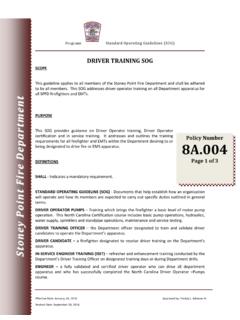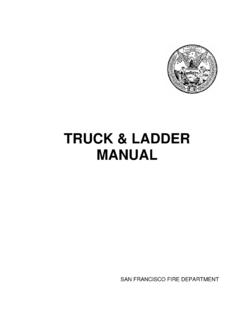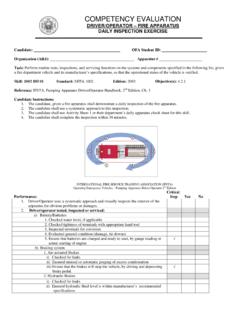Transcription of APPARATUS OPERATOR I - Pawling Fire
1 PUMPER OPERATOR Thirty-Two (32) Hours THIS IS INTENDED TO BE A GENERIC PUMPER OPERATOR COURSE. AT THE CONCLUSION OF THIS COURSE THE STUDENT SHOULD BE ABLE TO WALK UP TO ALMOST ANY PIECE OF fire APPARATUS EQUIPPED WITH A PUMP AND, WITH A LITTLE TIME, BE ABLE TO EFFECTIVELY PUMP WATER THROUGH HOSE FROM POINT "A" TO POINT "B". THE SUGGESTED COURSE SCHEDULE IS AS FOLLOWS: 1st WEEKEND Four (4) Hours: Pump Operation Part I (classroom) Four (4) Hours: Hydraulics Part I (classroom) Two (2) Hours: Water Supply (classroom) Six (6) Hours: Practical Application (drill ground) 2nd WEEKEND Four (4) Hours: Pump Operation Part II (classroom) Four (4) Hours: Hydraulics Part II (classroom) Two (2) Hours: Sprinklers & Standpipes (classroom) Six (6) Hours: Practical Application (drill ground) IT IS ESSENTIAL FOR APPARATUS OPERATORS TO KNOW THE SPECIFIC CHARACTERISTICS OF ANY INDIVIDUAL PIECE OF APPARATUS THAT THEY COULD BE CALLED UPON TO OPERATE.
2 THIS COURSE WILL NOT MEET THAT REQUIREMENT, BUT WILL HOWEVER, PROVIDE THE STUDENT WITH A GOOD BASIC FOUNDATION FROM WHICH TO START. Pumper OPERATOR Pump Operation (Part I) Jim Whelan 1 02/10/00 LESSON PLAN #PO-1 TITLE: PUMP OPERATION (Part I) TIME REQ'D: Eight (8) hours STANDARD: NFPA 1002 (1998 Edition) INST. LEVEL: Levels 1 - 2 - 3 Knowledge - Comprehension - Application MAT. NEEDED: Slide Projector Slide Program TV / VCR Media Resources Video " fire Pumpers & Pump Operation" Span Gauge Video "Flowminders" Action training Video "Foam fire Streams" Elkhart Brass Video "No City or Community Without Risk" Student Handouts fire Engine(s) Water Tender Water Supply static pressurized Monitor(s) equipped with non-automatic nozzles portable deck mounted Foam Producing Equipment Foam (Class "A") Flow Test Equipment REFERENCE: IFSTA " fire Department Pumping APPARATUS ", 7th Edition OBJECTIVES: At the end of this class, each APPARATUS OPERATOR shall be able to: SM Pg.
3 1 1. Identify three methods of power transfer from the vehicle engine to the pump Pumper OPERATOR Pump Operation (Part I) Jim Whelan 2 02/10/00 2. Identify the operating principles of single-stage and multiple-stage centrifugal pumps 3. Identify the major components and trace the flow of water through single-stage and multiple-stage centrifugal pumps 4. Identify corrective measures for the following conditions which may result in pump damage or unsafe operation: a.
4 Cavitation b. leaking fuel, oil or water c. overheating d. unusual noises e. vibrations f. water hammer 5. Recognize the theory and principles of priming the pump 6. Identify the characteristics and limitations of hard suction and soft suction pumper supply hose 7. Identify the percentages of rated capacity, rated pressures, and the capacity in gallons per minute at the rated pressures a fire department pumper is designed to deliver 8.
5 Identify all gauges on a department pumper and demonstrate their use 9. Identify a remedy for each of the following malfunctions which may occur during pumping operations: a. fluctuating pressure b. insufficient pump capacity c. insufficient pump pressure d. pump will not prime or loses prime 10. Demonstrate how to operate (including engaging the pump) the various types of fire APPARATUS available in the employing department SM Pg.
6 2 11. Demonstrate positioning and stabilizing a fire department pumper to operate at a fire hydrant and static supply source utilizing each existing pumper intake connection, given a pumper, a length of intake hose, and appropriate fittings or tools, so that the intake hose can be connected, without kinks, to the pump connection without repositioning the vehicle 12. Demonstrate production of effective hand streams, utilizing the sources specified below, so that the pump is safely engaged, all pressure control and vehicle safety devices are set, the rated flow of the nozzle is achieved, and the APPARATUS is continuously monitored for potential problems: Pumper OPERATOR Pump Operation (Part I) Jim Whelan 3 02/10/00 a.
7 Internal tank b. pressurized source c. static source 13. Demonstrate production of effective master streams, utilizing the sources specified below, so that the pump is safely engaged, all pressure control and vehicle safety devices are set, the rated flow of the nozzle is achieved, and the APPARATUS is continuously monitored for potential problems: a. internal tank b.
8 Pressurized source c. static source 14. Demonstrate procedures for pumping the following: a. maximum delivery rate from the APPARATUS water tank b. maximum rated capacity from a hydrant c. maximum rated capacity from draft 15. Demonstrate changing a water supply from the APPARATUS water tank to an external source, given a pumper with an operating fire attack line of 1-1/2 in.
9 Or larger, so that the flow of water to the attack line is not interrupted and the proper pressure is maintained 16. demonstrate the operations of fire APPARATUS pump pressure relief systems and pressure control governors 17. Demonstrate the operation of auxiliary cooling systems 19. Demonstrate the use of the volume/pressure transfer valve under actual pumping conditions (multi-stage pumps only) 20. The individual shall demonstrate connecting/engaging foam production system(s) and production of a foam fire stream.
10 21. Recognize the operating principles of the following types of APPARATUS foam systems: a. around the pump b. balanced pressure SM Pg. 3 c. eductor d. electronically metered injection 22. Identify the relationship of the four components of the foam tetrahedron in the production of an effective foam stream.










